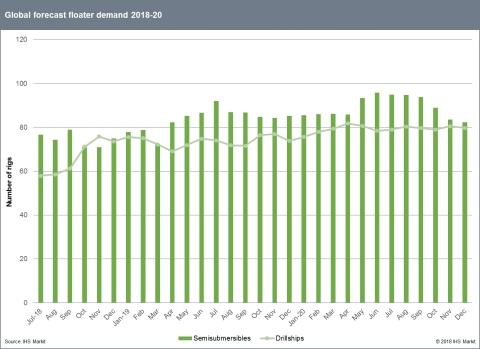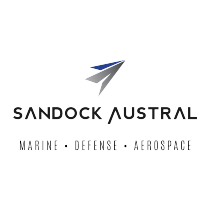Rising Oil Prices and Cost Efficiencies Driving Greater Global Demand for Offshore Drilling Rigs through 2020, IHS Markit Says
Consistently higher oil prices and greater cost-efficiency in offshore projects are driving increased demand for offshore drilling rigs through 2020, particularly for deepwater projects, according to new analysis from IHS Markit (Nasdaq: INFO), the leading global source of critical information and insight.
This press release features multimedia. View the full release here: https://www.businesswire.com/news/home/20180905005205/en/

Global forecast floater demand 2018-20 (Source: IHS Markit)
In its first worldwide mobile rig forecast for 2020, IHS Markit, which relies on data from its Petrodata RigPoint database, estimates the average global demand for mobile offshore drilling units, comprising jack-ups and floating rigs, is expected to increase by approximately 13 percent between 2018 and 2020 as the offshore market slowly emerges from its prolonged downturn. The company recently published its outlook for customers, entitled IHS Markit World Rig Forecast: Short-Term Trends.
IHS Markit expects global offshore rig demand will average 521 units in 2020, which exceeds the average of 453 units expected through 2018. These demand figures account for the entirety of 2018 through 2020, including seasonal fluctuations and regional trends.
“Broadly speaking, much of this increase in global demand can be attributed to the price of oil being sustained at a higher level than when the downturn was in full swing,” said Justin Smith, offshore rig analyst at IHS Markit and an author of the rig forecast. “In addition, costs associated with the offshore industry have been slashed in recent years. This has led operators to reconsider exploration, appraisal, and development programs that were not economically viable while the market was bottoming-out.”
While the demand for jack-ups, which work in shallow water, will improve during this period, the increase will primarily be driven by floating rigs, specifically semi-submersibles and drillships, as operators step up activity in deepwater areas around the globe, IHS Markit said.
“The vast majority of this offshore rig demand increase will come from the Middle East, led by Saudi Arabia, and other notable additions in Qatar and the United Arab Emirates,” Smith said. “Saudi Aramco alone will account for roughly a third of this increase as the operator continues its push for more offshore production, a sentiment echoed by Qatargas, which is aiming to increase its liquefied natural gas (LNG) exports.”
For jack-ups, demand is expected to climb from an average of 321 rigs this year to an average of 352 in 2020, which would be an improvement of 9.7 percent during the period. Meanwhile, smaller upticks in the jack-up rig segment are expected for several regions, including Northwest Europe, Central America, West Africa and the Indian Ocean. Interestingly, the U.S. Gulf of Mexico has made a considerable rebound from its lowest point of the downturn of four contracted units in October 2016. This year, the U.S. Gulf jack-up sector is expected to average about nine units, increasing to 11 by 2020, with potentially more on top of that, should local operators decide to undertake additional drilling programs, Smith said.
In the floating rig market, average annual semi-submersible rig demand is forecast to increase substantially in the short-term—by more than 25 percent—from an average of 71 units in 2018 to 89 units in 2020. Northwest Europe is responsible for a third of this expected improvement, but it should be noted that the semi-submersibles typically used in the region need to be equipped for harsh environments, for which fewer units are suited, thus making the region more competitive, IHS Markit said.
This has resulted in charter rates for the top echelon of units in this segment increasing by approximately 65 percent in some cases during the last year. In Norway, operators are increasingly focusing on securing high-specification, sixth-generation rig capacity, while U.K. operators still keep the market going for 1980s-built, third- and fourth-generation semi-submersibles.
“Fairly significant contributions to the semi-submersible rig demand are also coming from North and South America, as well as in the Asia Pacific market,” Smith said. “While not as busy as some other regions, semi-submersible demand for Australia/New Zealand and the Indian Ocean, especially Myanmar, is anticipated to increase, but the numbers for Southeast Asia and the Far East are likely to stay flat going into 2020, if not fall very slightly.”
Similarly, a significant increase is anticipated for the drillship portion of the floating rig market, for which demand in 2020 will average 79 units, marking a more than 27 percent increase from the average demand of 62 units for 2018. North and South America will be responsible for most of this growth, but for different reasons. In North America, the increase is mostly attributable to operators being reinvigorated to invest in development programs, while South America is benefiting from ExxonMobil’s exploration successes in Guyana and an influx of new operators in Brazil’s pre-salt areas, IHS Markit said.
Deepwater rigs, which are defined by IHS Markit as units that can operate in more than 3,000 feet of water, will see the most improvement with a number of longer-term programs set to begin in 2019 and to run throughout 2020 and beyond, particularly the drillship segment. In West Africa, the focus of the deepwater market will continue to be Nigeria, Angola, and Ghana, but high-profile campaigns continue to come to light for up-and-coming players, such as Namibia, Mauritania and Senegal, IHS Markit said.
“While fewer rig contracts have been signed during the last several years, we know that operators are making more plans for the future, and that growth is indicated in our forecast,” Smith said. “Once companies release their 2019 budget, we expect greater clarity as to how their leaders perceive the long-term health of the offshore market. Even without seeing their budgets yet, it is understandable that operators would want to take advantage of current cost reductions, which is being borne out as the number of tenders in the market for rigs has grown significantly this year,” Smith said.
Ahead of that, rig utilization rates have been slowly-but-steadily improving this year, a trend that is expected to continue. The total utilization of jack-ups, semi-submersibles, and drillships, which is defined as the share of all of the rigs that are contracted regardless of whether the rigs are actively being marketed as available for future contracts, hit a floor of 51 percent at the end of 2017 after more than a year at this level. The total utilization level is now at 56 percent and should keep climbing steadily, albeit very slowly, as market conditions continue to improve, IHS Markit said.
Marketed utilization, which is the proportion of units actually offered for work that are contracted, has also been edging up since early 2017, and has increased from more than 69 percent to nearly 74 percent. However, that number will need to be closer to 85 percent before contractors can start pushing significantly higher day-rates, Smith said.
“As available rig time for 2019 and 2020 begins to diminish, we expect operators that have not yet secured their rig slots will follow suit more rapidly so as to avoid paying higher day rates later in the market’s recovery, when rig availability is tighter,” Smith said. “Additionally, while contracts during the downturn tended to be for shorter terms, it is likely that oil companies will endeavor to lock in rigs for extended terms to secure units at lower rates for as long as possible.”
However, “despite a relatively robust improvement in demand during the next two years, the offshore rig market is still significantly oversupplied,” Smith said. “While growing demand will help improve day-rates in the future, this excessive supply will continue to hinder that progress.”
Rig contractors have accelerated the pace at which they are removing rigs from the global fleet in recent years, which has played a significant role in improving the global utilization rate. Since 2014, at least 189 rigs have been removed from the fleet, most of which have been older jack-ups and semi-submersibles, but still more units will need to be scrapped before day-rates can increase significantly, IHS Markit said. For reference, during that same period, a total of 133 new rigs were delivered. To that end, the total number of marketed offshore rigs currently stands at 647, and of those, 225 are at least 30 years old, according to IHS Markit.
“Still, it may be premature to assume that a huge portion of these older units will be scrapped during the next few years since 64 percent of them are currently drilling,” Smith said. “Some operators will use expiring contracts as an opportunity to get newer rigs, but those units will continue to compete with older ones that can generally offer lower rates, particularly as the availability of premium jack-ups tightens. The reality is that cost is key—not every operator needs or wants the highest-specification rig on offer.”
Compounding the issue, another 132 jack-ups, semi-submersibles and drillships are currently under construction, and only two of those already have contracts in hand. While the delivery dates for many of these will be delayed and some may be cancelled outright—in particular the floating rigs ordered by Sete Brasil—their mere presence will continue to have a downward pressure on day rates until the market achieves more balance, IHS Markit said.
“Regardless of whether it is with an old rig or a new one, operators will have a plethora of rigs from which to choose to satisfy their demand going into 2020,” Smith said.
(While not addressed in this report, information regarding tenders, contracting backlog, day rates and other offshore rig-market data also are tracked by Petrodata RigPoint.)
To speak with Justin Smith, please contact Melissa Manning at melissa.manning@ihsmarkit.com. For more information about the Petrodata RigPoint database by IHS Markit, or World Rig Forecast: Short Term Trends, please contact Paul Large at paul.large@ihsmarkit.com.
About IHS Markit (www.ihsmarkit.com)
IHS Markit (Nasdaq: INFO) is a world leader in critical information, analytics and solutions for the major industries and markets that drive economies worldwide. The company delivers next-generation information, analytics and solutions to customers in business, finance and government, improving their operational efficiency and providing deep insights that lead to well-informed, confident decisions. IHS Markit has more than 50,000 business and government customers, including 80 percent of the Fortune Global 500 and the world’s leading financial institutions. Headquartered in London, IHS Markit is committed to sustainable, profitable growth.
IHS Markit is a registered trademark of IHS Markit Ltd. and/or its affiliates. All other company and product names may be trademarks of their respective owners © 2018 IHS Markit Ltd. All rights reserved.
View source version on businesswire.com: https://www.businesswire.com/news/home/20180905005205/en/




